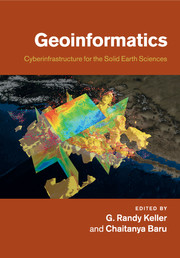Book contents
- Frontmatter
- Contents
- List of contributors
- Preface
- Introduction
- Part I Case studies from other disciplines
- Part II Modeling software and community codes
- Part III Visualization and data representation
- Part IV Knowledge management and data integration
- Part V Web services and scientific workflows
- 12 Service orientation in the design of a community hydrologic information system
- 13 Web services for seismic data archives
- 14 Development of robust data system for gravity and magnetic anomaly data: A case study of a community-based effort for point data
- 15 Scientific workflows for the geosciences: An emerging approach to building integrated data analysis systems
- 16 Online access and processing of LiDAR topography data
- 17 Use of abstraction to support geoscientists' understanding and production of scientific artifacts
- Part VI Emerging international and other efforts
- Index
- Plate section
- References
13 - Web services for seismic data archives
from Part V - Web services and scientific workflows
Published online by Cambridge University Press: 25 October 2011
- Frontmatter
- Contents
- List of contributors
- Preface
- Introduction
- Part I Case studies from other disciplines
- Part II Modeling software and community codes
- Part III Visualization and data representation
- Part IV Knowledge management and data integration
- Part V Web services and scientific workflows
- 12 Service orientation in the design of a community hydrologic information system
- 13 Web services for seismic data archives
- 14 Development of robust data system for gravity and magnetic anomaly data: A case study of a community-based effort for point data
- 15 Scientific workflows for the geosciences: An emerging approach to building integrated data analysis systems
- 16 Online access and processing of LiDAR topography data
- 17 Use of abstraction to support geoscientists' understanding and production of scientific artifacts
- Part VI Emerging international and other efforts
- Index
- Plate section
- References
Summary
Introduction
Seismology has a long tradition of sharing data across boundaries, be they international, institutional, or scientific domain. This sharing began decades before the era of digital data but modern methods of digital access to seismological data have revolutionized the ways in which these data are now available. Normally, seismological information is accessible on a global basis within seconds of real time. Since scientific studies also demand access to data spanning decades, access to voluminous archives of time series data is also necessary. This paper attempts to highlight some of the more recent applications of web services to provide access to seismological data of several types.
There are thousands of seismic stations operating in the world today; most are used for monitoring seismicity on a local, national, regional, or global scale. Broadband seismometers are now more and more common and greatly enhance the scientific usefulness of these data. The IRIS Data Management Center (DMC) is a major center that incorporates data from several seismic networks, including those funded by the US National Science Foundation, US Geological Survey, and networks funded by other international and national sources. As an international data center, the IRIS DMC actively works with international groups in a manner where data from many networks around the world, funded by international sources, are available through the IRIS DMC, as well as through distributed data centers.
- Type
- Chapter
- Information
- GeoinformaticsCyberinfrastructure for the Solid Earth Sciences, pp. 210 - 223Publisher: Cambridge University PressPrint publication year: 2011
References
- 1
- Cited by



